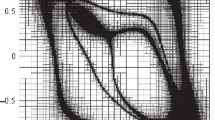Abstract
The relationship between the elements in the vector of any limit cycle due to rounding in ann-order direct-form digital filter is established. Some bounds on the elements in such vectors are also determined. Sufficient conditions for the accessibility of period-r limit cycles due to rounding inn-order digital filters are presented.
Similar content being viewed by others
References
T. A. C. M. Classen and L. O. G. Kristiansson, Necessary and sufficient conditions for the absence of overflow phenomenon in a second-order recursive digital filter,IEEE Trans. Acoust. Speech Signal Process., vol. pp. 509–515, Dec. 1975
T. A. C. M. Classen, W. F. G. Mecklenbrauker, and J. B. Peek, On the stability of forced response of digital filters with overflow nonlinearities,IEEE Trans. Circuits and Systems, vol. 22, pp. 692–696, Aug. 1975.
C. W. Barnes and A. T. Fam, Minimum norm recursive digital filters that are free of overflow limit cycles,IEEE Trans. Circuits and Systems, vol. 24, pp. 569–574, Oct. 1977.
L. B. Jackson, Limit cycles in state-space structures for digital filters,IEEE Trans. Circuits and Systems, vol. 26, pp. 67–68, Jan. 1979.
W. L. Mills, C. T. Mullis, and R. A. Roberts, Digital filter realizations without overflow oscillations,IEEE Trans. Acoust. Speech Signal Process., vol. 26, pp. 334–338, Aug. 1978.
T. A. C. M. Classen, W. F. G. Mecklenbrauker, and J. B. H. Peek, Effects of quantization and overflow in recursive digital filters,IEEE Trans. Acoust. Speech Signal Process., vol. 24, pp. 517–529, Oct. 1976.
S. R. Parker and S. F. Hess, Limit cycle oscillations in digital filters,IEEE Trans. Circuits Theory, vol. 18, pp. 687–697, Nov. 1971.
A. Lepschy, G. A. Mian, and U. Viaro, Zero-state accessibility and stability of optimal coupled-form digital filters with rounding,IEEE Trans. Circuits and Systems, vol. 35, pp. 590–594, May 1988.
T. Bose and D. P. Brown, Zero-input limit cycles due to rounding in digital filters,IEEE Trans. Circuits and Systems, vol. 36, pp. 931–933, June 1989.
T. Muir and W. H. Metzler,A Treatise on the Theory of Determinants, Dover, New York, 1960.
Author information
Authors and Affiliations
Rights and permissions
About this article
Cite this article
Bose, T., Brown, D.P. On limit cycles inn-order direct-form digital filters. Circuits Systems and Signal Process 10, 153–161 (1991). https://doi.org/10.1007/BF01183768
Received:
Issue Date:
DOI: https://doi.org/10.1007/BF01183768




